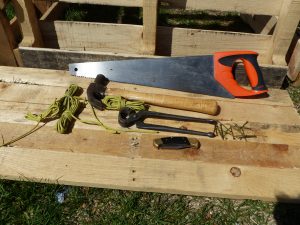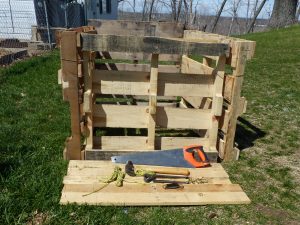In addition to gifting a family with fresh eggs, a backyard chicken flock yields another benefit. Their poop.
“Soil needs animal manure to maintain health, and few additions to garden soil help produce abundant vegetables as chicken poop compost,” said Drew Erickson, Farm Manager at Rodale Institute’s Midwest Research Center north of Cedar Rapids, Iowa.
Our garden produce is a side gift from our hens, and we use their manure in two ways. We sprinkle a thin layer directly on the garden soil and gently work it in. Chicken manure is nitrogen rich. Adding too much can over fertilize plants, so we only use a little directly. Most of it gets composted before it reaches the garden.
“Compost is a wonderful soil additive. Good compost is soft, fluffy, rich in many plant nutrients and has a pleasant earthy aroma. No gardener ever seems to have too much of it,” said master gardener, Iris Muchmore.
Building a compost bin and allowing nature to convert raw manure, wood chips, yard waste and organic kitchen matter is a productive and easy way to use chickens to increase garden abundance.
Building An Almost Free Compost Bin
Around three billion pallets are circulating around the world. Many reach their destination, only to be tossed into a scrap pile. They seem to be everywhere, especially in industrial zones. Companies pay to have pallets hauled to the landfill, so giving them away saves them money. Ask the manager for permission to take pallets and usually the answer is, “Sure, help yourself”. Four like sized pallets make an ideal compost bin.
Choose safe pallets of the same size and in good condition to make a compost bin. Most pallets are stamped with the logo of the International Plant Protection Convention (IPPC) and several codes. All but locally made pallets must be treated to kill insect or plant pests lurking in the wood. Most pallets are heated in giant ovens to kill pests. They are stamped HT and are safe to use. Others are treated with methyl bromide, a hazardous chemical. They are stamped MB. Leave them alone!
Other pallet codes are interesting. Usually, the country of origin code is stamped on each one. The code key can be found on www.universalpallets.com and other websites. We’ve scrounged beautiful wood from Latvia, Poland, and Thailand as well as more common ones from the United States and Canada.
Four safe pallets of the same size can be easily made into a compost bin that will last a few years.
Assembling the Pallet Compost Bin

Materials needed:
* Four pallets of the same size. It’s a good idea to have a spare for parts.
* 50 feet of light nylon or poly rope and a knife to cut it.
* Hammer, nails, and handsaw. These are needed only if broken pallet slats need to
be replaced by new boards scrounged from the fifth pallet.
* Pliers to pull out exposed staples or nails.
To make the Bin:
Stand the four pallets upright to form a box.
Cut the rope into two-foot sections, thread it through two pallet corners and tie
tie them together so they form a right angle. Do the same with the other three
corners. Make rope ties toward the top and bottom of each corner.
That’s it. The bin is ready to fill.

Filling the Compost Bin
Nearly any organic material will decompose into compost, but a chicken manure/wood chip blend (called litter from the bottom of the coop) is our main ingredient. Every spring and fall we dig it out of the coop and put it in the bin…..layered with leaves or lawn clippings. We soak the mix down with water and bacteria go to work.
Our chickens love snacking on kitchen waste, but not every organic material from the kitchen is appropriate food. We keep a small pail by our sink and add citrus and avocado peels, eggshells, and food scraps. Every day we bring the pail to the compost bin, which is just outside the chicken run. Eggshells, grapefruit rinds, avocado skins, and anything else the chickens won’t or shouldn’t eat goes into the bin while tidbits they will eat go into the run.
The Fast Way. The Easy Way.
Most bacteria need oxygen to break down organic material. Occasionally forking the composting mix from one bin into another fluffs it up, adds oxygen, and lets the material heat up and compost in just six or eight weeks. It’s fast but takes work.
We do it the easy way by filling our bin with litter and other organic material, soaking it down, and letting it age without forking it as described above. After six months it’s ready for the garden.
Many types of compost bins can be purchased ready-made, and plans for homemade ones are common on the internet. None are as inexpensive as a compost bin made from scrounged pallets.